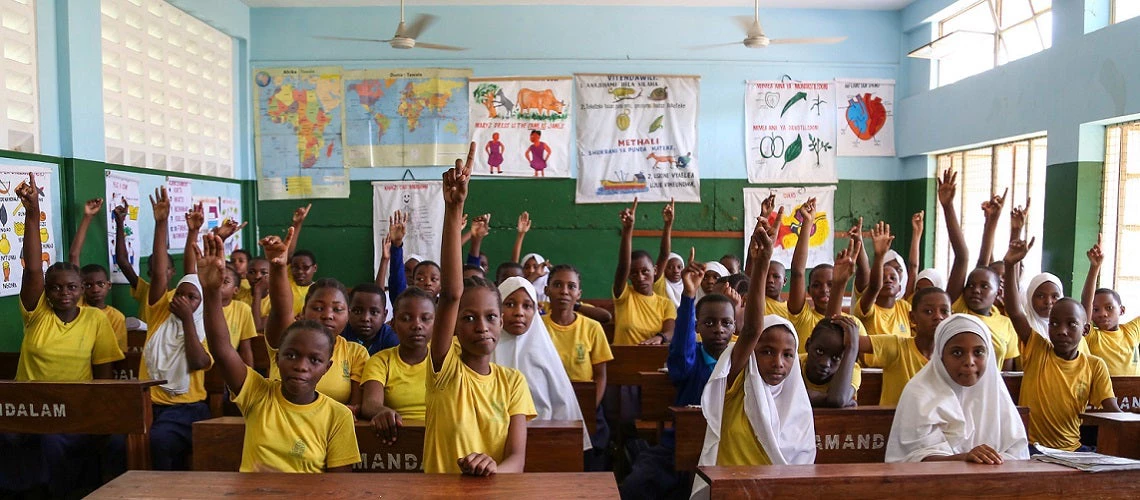 Students in Primary Seven at Zanaki Primary School in Dar es Salaam, Tanzania
Students in Primary Seven at Zanaki Primary School in Dar es Salaam, Tanzania
There is now a wealth of evidence that ensuring a well-educated, healthy, and well-nourished population can pay bigger dividends to the economy than investing in roads and bridges alone. The World Bank Group’s Human Capital Project, launched in 2018, aims to accelerate more and better investments in people as a key way to unlock greater equity and inclusive growth.
Climate change, however, poses a risk to that aim: rising temperatures and more intense heat waves, floods, and other extreme weather events all pose a serious threat, not only to the infrastructure that is visible around us, but also to the human capital of billions of people.
Take temperature rise, for instance:
- 2019 was the second-hottest year since modern record-keeping began in 1880, just behind 2016, according to analyses conducted by NASA and NOAA. It continued the planet's long-term warming trend: the past five years have been the warmest of the last 140 years.
- Rising temperatures have exposed millions more to heat waves.
- Heat waves adversely affect health outcomes. For example, a lack of adequate cold storage and refrigerated transport contributes to over 1.5 million vaccine-preventable deaths each year.
- Extreme heat can also have significant impacts on learning, by inhibiting cognitive skill development, as well as on labor capacity, by reducing hourly work capacity. Estimates project that, by 2050, work hours lost due to heat may be as high as 12% in the worst affected regions of South Asia and West Africa. That means a 6% loss in annual GDP.
Opportunities for win-wins
At the same time, a stronger human capital base can help communities adapt to a changing climate, and reciprocally, investments in low-carbon, climate-resilient development can help countries unlock further human capital gains.
"A stronger human capital base can help communities adapt to a changing climate, and reciprocally, investments in low-carbon, climate-resilient development can help countries unlock further human capital gains."
Shifting to a new climate economy could generate 65 million new low-carbon jobs globally in 2030, more than offsetting employment reductions in declining sectors and leading to a net employment gain of 37 million jobs. This transition is not only about phasing out polluting and unsustainable activities in various sectors, but also about diversifying local economies, generating new jobs and industries as well as new services and skills, all of which requires new types of investment and accompanying policies. The transition can also be designed to boost female labor force participation, ensuring a more inclusive employment landscape.
Education is an essential element of the global response to climate change. It can help people understand and address the impact of global warming; it also boosts their adaptive capacity and thus reduces vulnerability. STEM subjects in secondary education can help arm students with the skills to tackle climate change issues both now and in the future, while cutting-edge research in universities will be critical in delivering the climate-smart solutions of tomorrow.
Conversely, boosting investments in human capital can also support a shift to low-carbon services that reduce greenhouse gas emissions. These could include improving building design and expanding the construction of health and educational facilities; increasing the use of renewable energy and energy efficiency interventions; scaling up waste reduction and management; and improving transport and water consumption policies.
These changes can help reduce air pollution, which causes 7 million deaths worldwide annually, with health impacts costing over 4% of GDP for the 15 highest emitting countries.
Solutions that deliver climate-smart human capital outcomes
The World Bank has been stepping up its support to client countries to develop climate-smart human capital interventions. These include:
- The Regional Diseases Surveillance Systems Enhancement project in West Africa, which aims to strengthen integrated vector-borne disease management approaches and align the timing and location of activities with potential climate-induced shifts in disease burden.
- In Bangladesh, a secondary education project incorporates adaptation measures in the construction and retrofitting of facilities such as schools, labs, and training centers.
- The Chad Social Safety Nets project is building the resilience of the poorest through cash transfers, the creation of a social registry responsive to shocks, and program scale-up in response to weather shocks, among other measures.
- The Egypt Healthcare Reform Project is supporting the establishment of a climate and health research program that is accompanied by higher education and a specialized skills program to reduce energy consumption in health care systems.
The way forward for human capital and climate action
Against the backdrop of the global COVID-19 crisis, clear touchpoints have emerged between human capital and addressing climate change: ranging from, in the first instance, common lessons from the front lines of disaster response, such as expanding the use of adaptive safety nets, to the upcoming focus on economic recovery and investments that can also achieve longer-term goals.
A number of emergency health response measures being promoted as part of the coronavirus response in client countries can also support long-term climate action. For example, strengthening disease surveillance systems and laboratory capacity for COVID-19 will also enhance the wider ability to respond to climate-related communicable disease threats.
Investments in the rehabilitation and equipping of health care facilities, including the medical cold chain, can improve climate adaptive capacity for the sector and the people it serves. Likewise, policy actions to address the economic fallout of the pandemic can also support public investments in green infrastructure, which will deliver jobs in the short term and climate dividends in the long term.
Many climate-smart interventions that support the accumulation of human capital are relatively low-cost. And, in fact, by delivering multiple benefits, including in terms of enhanced climate change adaptation and mitigation for communities, they increase their cost-effectiveness for beneficiaries. Unlocking a new climate economy for countries – building human capital and tackling climate change together – can help lay the foundations for sustainable economic prosperity.



Join the Conversation